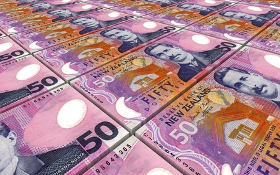
The New Zealand dollar rallied strongly since the last year, though it was moving sideways since the summer months of this year. Last week was very good for the currency despite the sharp decline of New Zealand’s economy as the kiwi rivaled the Japanese yen for the title of the strongest currency on the Forex market. But what this week holds for the New Zealand dollar?
Last week’s macroeconomic data was somewhat inconclusive. While New Zealand’s gross domestic product demonstrated a sharp drop of 12.2% last quarter, which was the biggest contraction on record, it was still not as bad as pessimistic predictions. This week is very light on macro releases, and traders will turn all their attention to the monetary policy meeting of the Reserve Bank of New Zealand.
The RBNZ will announce its policy decision on Wednesday. Analysts do not expect any notable changes to the existing policy after the big adjustment in the previous month. While the central bank did not change its benchmark interest rate at the August meeting, leaving it at 0.25%, the Large Scale Asset Purchase program got a significant boost from NZ$40 billion to NZ$100 billion. Yet even without changes, the statement will be important as market participants will watch its wording, especially any mentions of negative interest rates. Indeed, last month the central bank talked about its plans about implementing negative rates:
Reflecting a possible need for further monetary stimulus, the Committee also agreed that a package of additional monetary instruments must remain in active preparation. The deployment of such tools will depend on the outlook for inflation and employment. The package of further instruments includes a negative OCR supported by funding retail banks directly at near-OCR (a Funding for Lending Programme). Purchases of foreign assets also remain an option.
But experts think that even if the RBNZ continues to plan for negative rates it will not happen till the next year. With relatively high inflation, the central bank has no incentive to hurry with making its already accommodative monetary policy even looser.
As for macro reports this week, according to the data released by the RBNZ on Monday, credit card spending dropped by 11.9% in August following the 5.0% drop in July, year-on-year. Month-on-month, the indicator fell by 5.5% after increasing by 3.5% in the previous month.
Statistics New Zealand will release a report on the trade balance in August on Thursday. Economists predicted that it will show a deficit of NZ$350 million. The balance was in the positive territory in July, showing a surplus of NZ$282 million.
As for analysts’ forecasts, DailyFX was neutral on the New Zealand dollar, explaining that the central bank’s policy meeting can be positive to the currency but the general gloomy mood among investors will likely be weighing on the currency. Indeed, this week’s trading started with risk aversion due to the surge of new coronavirus cases. While the general risk-off sentiment is detrimental to the kiwi in its own right, fears of a new pandemic have an additional negative impact on the currency as investors are worried that a new outbreak and lockdown can be a deathblow to the New Zealand tourism industry, which is an important part of the country’s economy.
If you have any questions, comments, or opinions regarding the New Zealand Dollar, feel free to post them using the commentary form below.